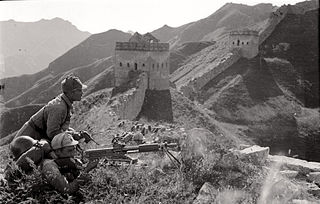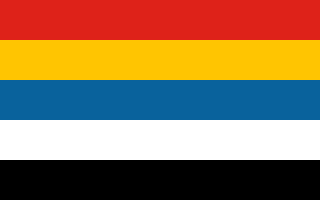Two existing armies have been known in English as the Chinese Army:
For the Chinese army between 1927 and 1947, see:
For Chinese armies before 1912, see:

The National Revolutionary Army, sometimes shortened to Revolutionary Army (革命軍) before 1928, and as National Army (國軍) after 1928, was the military arm of the Kuomintang from 1925 until 1947 in the Republic of China. It also became the regular army of the ROC during the KMT's period of party rule beginning in 1928. It was renamed the Republic of China Armed Forces after the 1947 Constitution, which instituted civilian control of the military.
Military of China may refer to:

The Eighth Route Army, officially known as the 18th Group Army of the National Revolutionary Army of the Republic of China, was a group army under the command of the Chinese Communist Party, nominally within the structure of the Chinese military headed by the Chinese Nationalist Party during the Second Sino-Japanese War.
Chinese Air Force may refer to:
The ranks in the Chinese People's Liberation Army Air Force are similar to those of the Chinese Army, formally known as the People's Liberation Army Ground Force, except that those of the PLA Air Force are prefixed by 空军 meaning Air Force. See Ranks of the People's Liberation Army or the article on an individual rank for details on the evolution of rank and insignia in the PLAAF. This article primarily covers the existing ranks and insignia.
The history of the Chinese People's Liberation Army began in 1927 with the start of the Chinese Civil War and spans to the present, having developed from a peasant guerrilla force into the largest armed force in the world.

Xie Fuzhi was a Communist Party of China military commander, political commissar, and national security specialist. He was born in 1909 in Hong'an County, Hubei and died in Beijing in 1972. Xie was known for his efficiency and his loyalty to Mao Zedong, and during the Cultural Revolution he played a key role in hunting down the Chairman's enemies in his capacity as Minister of Public Security from 1959–1972.
The People's Liberation Army is the armed forces of the People's Republic of China. It may also refer to:
Revolutionary War(s) may refer to:
The term national army typically means the lawful army of the state as distinct from rebel armies or private armies that may operate there.

The Nationalist government, officially the National Government of the Republic of China, also known as Second Republic of China but most commonly known simply as the Republic of China, refers to the government of the Republic of China between 1 July 1925 and 20 May 1948, led by the Kuomintang. The name derives from the Kuomintang's translated name "Nationalist Party".
People's Army/Armed Forces is/was the title of the armed forces of several countries:
People's Revolutionary Army may refer to:

The People's Liberation Army uses a system of theater commands, of which there are now five:
The Ukrainian Army or Ukrainian Ground Forces are the land force component of the Military of Ukraine.
The Chinese Armed Forces may refer to:
Military ranks of China can refer to:
The fourth encirclement campaign against the Hubei–Henan–Anhui Soviet was an encirclement campaign launched by the Chinese Nationalist Government that was intended to destroy the communist Hubei–Henan–Anhui Soviet and its Chinese Red Army in the local region. It was responded by the Communists' fourth counter-encirclement campaign at Hubei–Henan–Anhui Soviet, also called by the communists as the fourth counter-encirclement campaign at Hubei–Henan–Anhui Revolutionary Base, in which the local nationalist force defeated the local Chinese Red Army and overran their soviet republic in the border region of Hubei, Henan, and Anhui provinces from early July 1932 to 12 October 1932. However, the Nationalist victory was incomplete because they had concluded the campaign too early in their jubilation, resulting in the bulk of the communist force escaped and established another communist base in the border region of Sichuan and Shaanxi provinces. Moreover, the remnant local communist force of the Hubei–Henan–Anhui Soviet had also rebuilt the local Soviet republic by taking advantage of the early nationalist withdrawal, and as a result, nationalists had to launch another encirclement campaign later to repeat the effort again.
The fifth encirclement campaign against the Hubei–Henan–Anhui Soviet was an encirclement campaign launched by the Chinese Nationalist Government that was intended to destroy the communist Hubei–Henan–Anhui Soviet and its Chinese Red Army in the local region. It was responded by the Communists' fifth counter-encirclement campaign at Hubei–Henan–Anhui Soviet, also called by the communists as the fifth counter-encirclement campaign at Hubei–Henan–Anhui Revolutionary Base, in which the local Nationalist force defeated the local Chinese Red Army and overran their soviet republic in the border region of Hubei, Henan, and Anhui provinces from 17 July 1933 to 26 November 1934. In mid November 1934, the local communists were forced to abandon their base and begun their Long March, and hence the communists usually choose their beginning of the Long March as the end of the campaign, but in reality, the campaign was longer, lasting for another half a month till the end of November 1934 when the local Chinese Red Army fought its way to escape.

China, officially the Republic of China (ROC), was a sovereign state based in mainland China prior to the relocation of its government to Taiwan and the proclamation of the People's Republic of China. At a population of 541 million in 1949, it was the world's most populous country. Covering 11.4 million square kilometres, it consisted of 35 provinces, 1 special administrative region, 2 regions, 12 special municipalities, 14 leagues, and 4 special banners. This period is often referred to as the Republican Era in mainland China or the Mainland Period in Taiwan.